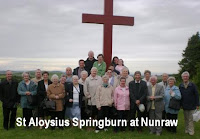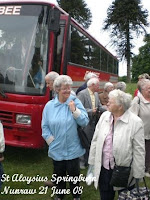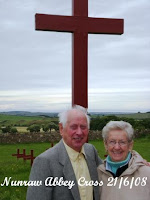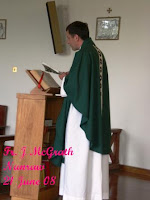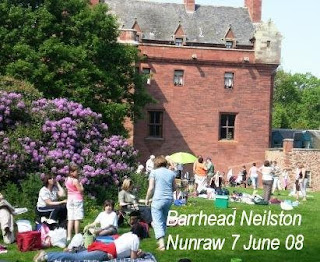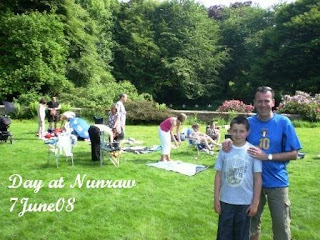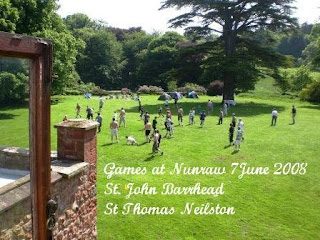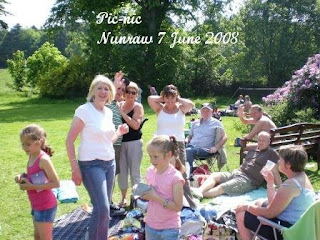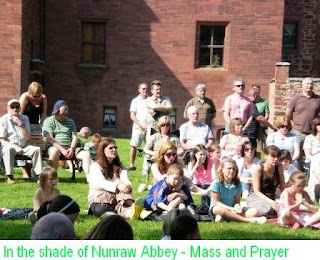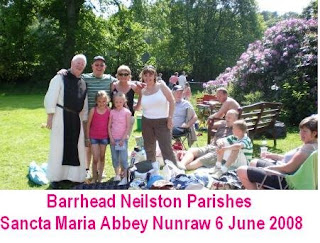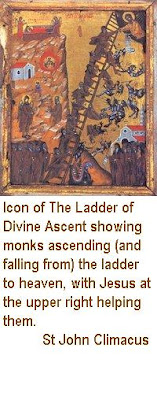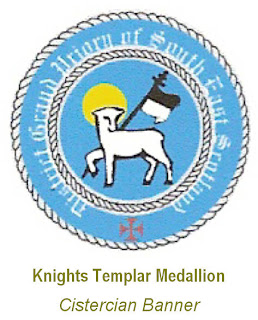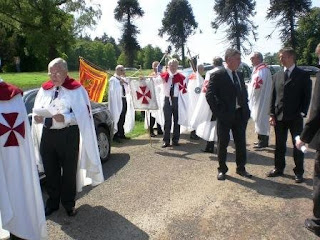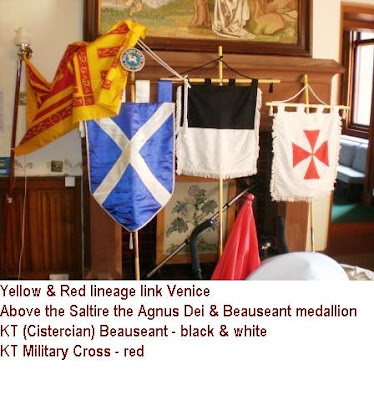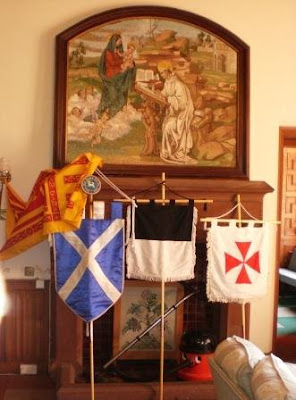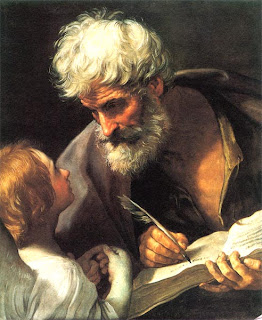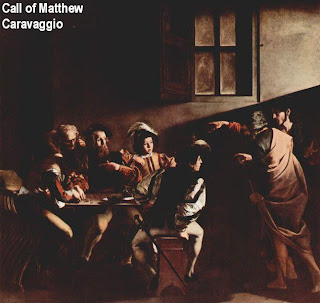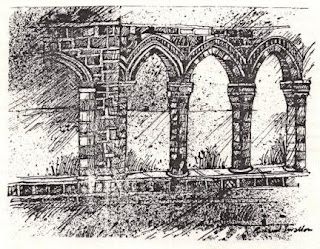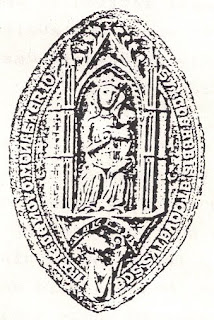Vocations to the Priesthood
In union with the other Christian Martyrs of Algeria
we commemorate the Seven Atlas Martyrs
on their anniversary 21 May 2008.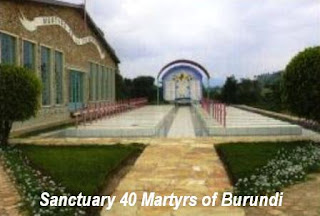
In our Post for the 21st May our prayer extended beyond our seven Cistercian Brothers. That extension was dramatically underlined for us by the account of the 40 Young Seminarians martyred in Burundi.
Abbot Hugh Gilbert OSB has drawn my attention to the moving article in
Pluscarden Benedictines
No. 145. Spring 2008
As the author points out, the story is scarcely known in English speaking countries.
I hope the following Links and References will make this example of young men aspiring to the priesthood an inspiration, and may promote and strengthen the faith of those attracted to the priestly vocation.
Excerpts from article, “The Seminarians of Buta Martyrs of Christian Brotherhood, 30 April 1997”.
It is against the background of the early years of this Civil War of Burundi that the story of Buta belongs. . . . . . . . . . .
Providential Preparations
In 1965, in the southern province of Bururi, a junior seminary was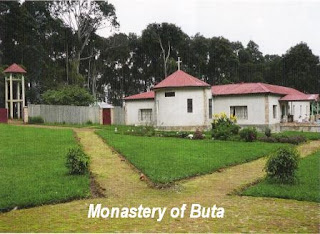 established. The students - more than a hundred of them, in their teens and early twenties - were ethnically both Hutu and Tutsi. It is worth mentioning that attendance at a junior seminary does not necessarily imply an intention for priesthood, and that in Africa students will often be older than they would in any European or North American equivalents. In 1986, a diocesan priest, P. Zacharie Bukuru, was made Rector.
established. The students - more than a hundred of them, in their teens and early twenties - were ethnically both Hutu and Tutsi. It is worth mentioning that attendance at a junior seminary does not necessarily imply an intention for priesthood, and that in Africa students will often be older than they would in any European or North American equivalents. In 1986, a diocesan priest, P. Zacharie Bukuru, was made Rector.
Shortly after, the seminary was secularised by the government, and then in 1988 returned to the Church.
Looking back on the years prior to the tragedy of 1997 and on his own ministry, Fr. Zacharie was able to see the guiding, preparing hand of Providence. It is also clear to others that he was an inspired pedagogue and spiritual father for these youngsters. From the beginning of his service there the Rector was haunted by a premonition of death. Its immediate cause was the overloaded state of the dormitory. To reassure himself he would quietly visit it each night after the boys were asleep. Standing there in the dark listening to their peaceful breathing he felt the beginning of a deep friendship with them. More importantly, he knew it was part of his task to educate them to Christian brotherhood, beyond their ethnic identities. After the political events of 1993-1994 this became even more imperative. The racial tensions tended to affect schools very seriously, with often one or other group attacking the other, or deserting the school for fear of being massacred, or expelling the staff and taking the school over. P. Zacharie noticed how the youngsters were already tending to recreate more and more in ethnic groups. At one point a group of young Hutu students planned to desert the seminary, saying that they were in peril from their Tutsi companions. The staff managed to prevent this, though shortly after six such seminarians did leave. They were to join a rebel group and be the ones who later would guide it in the attack on their former confreres.
The Rector then began holding regular meetings with all the students. They would study together the news that was coming in, study and 're-read' the history of the conflict, especially the events of 1972 in which their parents had been involved. This allowed things hitherto kept under to surface. The boys began to express their fears, their sometimes one-sided or distorted understanding of events, and their ethnic prejudic:es. The only rule in these exchanges was that if one youngster insulted another, he was told that he was insulting everyone, bidden to leave the room for a time, and then return and apologise. Gradually the students discovered how worthwhile it was to search for the objective truth about their country's history. They learned to respect other perspectives and distance themselves from extremism. Gradually a culture of peace emerged. There grew a desire to disengage from the inherited conflicts and to move towards a better, reconciled future.
 At the same time - another stroke of pedagogical genius - the Rector realised how worthwhile it would be to teach the boys the traditional Burundian dances. These were in any case in danger of being forgotten. He got the best dancers in the country to teach both students and professors. The effect was marked. Dancing bonds. This too, and sport (lots of it!), and the encouragement of societies began to create an extraordinary sense of brotherhood in the place. The students themselves founded an association to help local people cope with Aids, another to promote the environment. As the economic situation worsened, they began more manual work, which proved another bond, uniting staff and students as well as the students themselves. Various Youth and Catholic Movements also took root in the seminary: Scouts, Focolari, Schoenstatt etc., all of which helped. There was communal study of the Sermon on the Mount. And not least there was prayer, especially at the weekends, with adoration of the Blessed Sacrament all through the night. All this was happening when so much education in the country was in crisis. The seminary began to become well known as a happy exception. The Prime Minister himself came to affirm all this. But those in the country who preferred to foment division were not pleased.
At the same time - another stroke of pedagogical genius - the Rector realised how worthwhile it would be to teach the boys the traditional Burundian dances. These were in any case in danger of being forgotten. He got the best dancers in the country to teach both students and professors. The effect was marked. Dancing bonds. This too, and sport (lots of it!), and the encouragement of societies began to create an extraordinary sense of brotherhood in the place. The students themselves founded an association to help local people cope with Aids, another to promote the environment. As the economic situation worsened, they began more manual work, which proved another bond, uniting staff and students as well as the students themselves. Various Youth and Catholic Movements also took root in the seminary: Scouts, Focolari, Schoenstatt etc., all of which helped. There was communal study of the Sermon on the Mount. And not least there was prayer, especially at the weekends, with adoration of the Blessed Sacrament all through the night. All this was happening when so much education in the country was in crisis. The seminary began to become well known as a happy exception. The Prime Minister himself came to affirm all this. But those in the country who preferred to foment division were not pleased.
So we come to 1997. Easter itself seemed to be special, with many of the students saying afterwards how moved they had been by the liturgy of Good Friday. Then two weeks after Easter they had their communal retreat, animated by members of a local Foyer de Charite. This too seems to have been a time of unusual grace. At the final Mass everyone rose as if at the bidding of an electric current and danced, and were transported by joy, including the Rector. Then afterwards, after their days of silence, the boys began to speak. "I'm going to be a priest," said one, and immediately others burst out laughing because that's what they had decided too .. And others said, "In this retreat I've really met God face to face." One said to the Rector, memorably in view of what was to come: "Father, why have you never talked to us about Paradise?" And they began to speak of peace, justice, love, the priesthood, the Church in a way the Rector had never heard them do before. He realised something unique had happened, and that some of them had been given a glimpse of paradise. "Never in my life had I experienced such a depth of brotherly communion, or so manifest a presence of the Holy Spirit." This was the 24th April. Six days later, forty of them would be dead.
It's also worth mentioning an experience of the Rector's, which he dates to 5 April. He was praying, and there came to him a strong sense that something very good and very wonderful was about to happen to him, and that all he had to do to prepare for it was pray. He did thereafter find himself praying with greater ease.
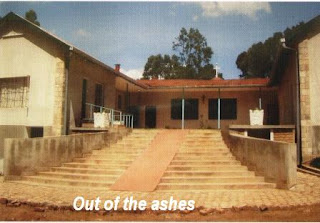 By a strange Providence, in 1997 the Church in Burundi as celebrating its centenary, and by another the late Cardinal Lustiger, whose own Jewish parents had been "ethnically cleansed" in Auschwitz, was the Pope's representative at the closing ceremonies later that year. In their course, he said this to the people ofBurundi:
By a strange Providence, in 1997 the Church in Burundi as celebrating its centenary, and by another the late Cardinal Lustiger, whose own Jewish parents had been "ethnically cleansed" in Auschwitz, was the Pope's representative at the closing ceremonies later that year. In their course, he said this to the people ofBurundi:
"Remember what happened at dawn on 30th April, in the dormitory of the seminary at Buta: forty of your own children - of different ethnic origins - remained united as brothers and preferred to die together rather than betray each other. Some of them gave up their lives praying for their murderers with the words, 'Lord forgive them; they know not what they do.' This is the highest example of human greatness and of love of neighbour which it is possible to give on this earth as followers of Jesus. In France we have heard tell of many other no less admirable examples given by many Christians of your country. Together we thank God for this testimony which your children, parents and friends have given to the power of the love of Christ. Keep the memory of them as something precious ... They are martyrs of charity and offaith; they are an example for the Christians of the whole world and for the whole of humanity. With the Virgin Mary and all the saints, they too are praying for you. In the name of the Lord Jesus Christ, in the name of the whole Church, I say thank you to the Church of Burundi for having given birth to them."
The cause for the beatification of these young men has been opened.
LES QUARANTE JEUNE MARTYRS DE BUTA, BURUNDI 1997: Frere a la Vie, a la Mort
Bukuru, Zacharie
A biographical account of the author's experiences of the violence between Hutu and Tutsi in Burundi during the 1990s, and the murder of 40 young seminarians who refused to acknowledge segregation based on ethnicity. The author reflects on the dialectic between history and memory and the necessity of remembrance and understanding. Text in French. BNS, 248pp, FRANCE. KARTHALA.
2004 2845865384 Paperback
Translations pending, “The Forty young Martyrs of Buta, Burundi: Brothers in Life and in Death”.
Web: africabookcentre.com
The Martyrs of the Christian Fraternity, BURUNDI
WEB: acb.org/stories/burundi/martyrs_burundi.html
Dictionary of African Christian Biography
God is good and we have met Him. --The Martyrs of the Christian Fraternity d. 30 April 1997
The isolated, mountainous country of Burundi, often called "the Switzerland of Africa," has been the scene of some of Africa's bitterest ethnic violence, a spillover from the genocide in neighboring Rwanda. At about 5:30 in the morning of April 30, 1997, armed invaders allegedly from the Hutu rebel group CNDD (the National Council for the Defence of Democracy) attacked the Roman Catholic Seminary at Buta, killing forty young seminarians between the ages of fifteen and twenty. Since the beginning of the country's most recent civil war in October 1993, the seminary in the country's south had been a tranquil refuge for members of the two warring ethnic groups. The pastoral Hutu and more nomadic Tutsi have been locked in deadly genocidal war since 1972.
The seminarians themselves had made a special point of living in a Christian fraternity, where love of Christ was more important than ethnic origins. They had just completed an Easter season retreat before their massacre. Fr. Nicolas Niyungeko, rector of the Sanctuary of Buta in the Diocese of Bururi, wrote of the seminarians:
At the end of the retreat, this class was enlivened by a new kind of spirit, which seemed to be a preparation for the holy death of these innocents. Full of rejoicing and joy, the word in their mouths was "God is good and we have met Him." They spoke of heaven as if they had just come from it, and of the priesthood as if they had just been ordained .... One realized that something very strong had happened in their heart, without knowing exactly what it was. From that day on, they prayed, they sang, they danced to church, happy to discover, as it were, the treasure of Heaven.
The following day, when the murderers surprised them in bed, the seminarians were ordered to separate into two groups, the Hutus on one hand, the Tutsi on the other. They wanted to kill some of them, but the seminarians refused, preferring to die together. Their evil scheme having failed, the killers rushed on the children and slaughtered them with rifles and grenades. At that point some of the seminarians were heard singing psalms of praise and others were saying "Forgive them Lord, for they know not what they do." Others, instead of fighting or trying to run away, preferred helping their distressed brothers, knowing exactly what was going to happen to them
Their death was like a soft and light path from their dormitory to another resting place, without pain, without noise, nor fear. They died like Martyrs of the Fraternity, thus honouring the Church of Burundi, where many sons and daughters were led astray by hatred and ethnic vengeance.[1]
Forty days after the massacre, the small seminary dedicated its church to Mary, Queen of Peace, and it has since, according to Fr. Niyungeko, "become a place of pilgrimage where Burundians come to pray for the reconciliation of their people, for peace, conversion, and hope for all. May their testimony of faith, unity, and fraternity send a message for humankind and their blood become a seed for peace in our country and the world."
Almighty God, you call your witnesses from every nation and reveal your glory in their lives. Make us thankful for the example of the Martyrs of the Christian Fraternity of Burundi, and strengthen us by their example, that we, like them, may be faithful in the service of your kingdom, through Jesus Christ our Lord. Amen. --Celebrating Common Prayer, 489.
Frederick Quinn
Notes: 1. Nicholas Niyungeko, "What's New in Burundi!" e-mail from Servane Ronin-Vermauwt to Frederick Quinn, January 10, 2001.
See: African Saints: Saints, Martyrs, and Holy People from the Continent of Africa, copyright © 2002 by Frederick Quinn, Crossroads Publishing Company, New York, New York. All rights reserved.

